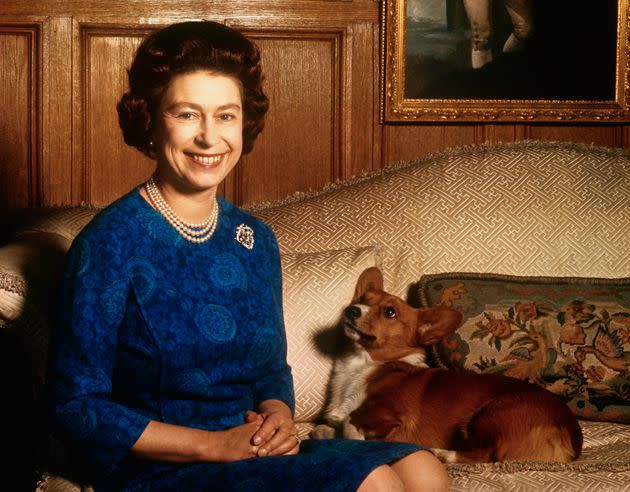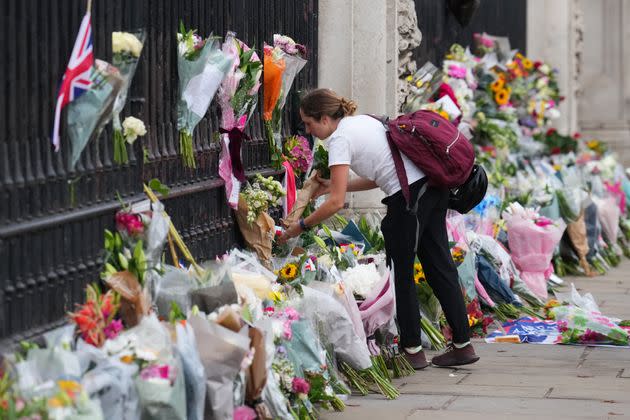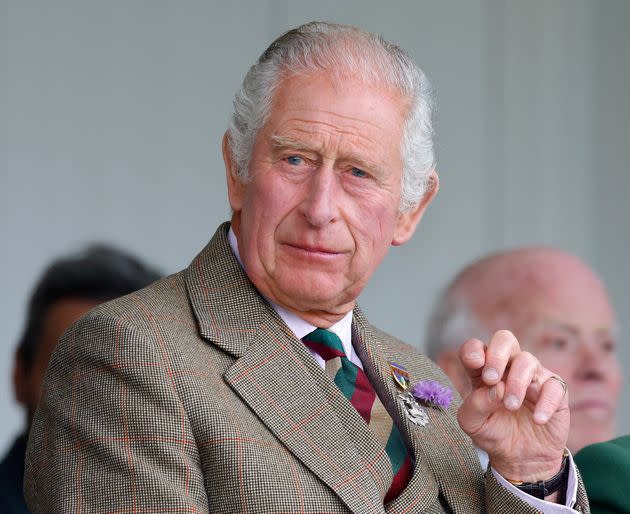What Is A Period Of National Mourning? Everything You Need To Know

Queen Elizabeth II smiles in the salon at Sandringham House. (Photo: Bettmann via Getty Images)
Queen Elizabeth II, the UK’s longest-serving monarch, died at Balmoral on Thursday aged 96.
She came to the throne in 1952 and during her 70-year reign witnessed enormous social change.
Her death will be marked by a period of national mourning. Her family and staff will also take part in a longer period of royal mourning.
The British government has now issued details on national mourning and guidance on how the public may choose to mark this historic moment.
What Is A Period Of National Mourning?
National mourning is described as a “time for reflection” in response to the demise of the sovereign, a member of the royal family or a very prominent person in national life.
Essentially, it is a set period of time in which the public will be able to pay their respects to the Queen.
Guidance issued by the cabinet office said that mourning was “very personal” and individuals, families and organisations may want to mark the queen’s death “in their own way”.
“There is no expectation on the public or organisations to observe specific behaviours during the mourning period,” the guidance said.
For many, it will likely involve the cancellation of some cultural events and acts of memorial.
As a mark of respect to Her Majesty Queen Elizabeth II, this weekend’s Premier League match round will be postponed.
— Premier League (@premierleague) September 9, 2022
Major sporting events are being postponed and flags flown at half mast as a mark of respect.
The Premier League and EFL have already confirmed that they are postponing matches scheduled for this weekend.
Books of condolences have been placed in town halls so people can pay their own tributes to the Queen.
Normal government business is suspended, with no ministerial visits, statements or press releases.
Civil servants have been asked to carry out their duties respectfully and wear appropriate clothing. Schools will remain open, public services will continue and museums and galleries are not obliged to close.
MPs and staff are being advised to wear sombre clothing when attending the parliamentary estate.

A woman pauses next to flowers and tributes to Queen Elizabeth II outside Buckingham Palace on September 9, 2022. (Photo: Carl Court via Getty Images)
How Long Will The Period Of Mourning Last?
The national period of mourning starts on Friday and is set to last for ten days.
What Is The Government Advising?
Businesses and other organisations wishing to pay their respects by half-masting flags or holding silences can follow the guidance that has been issued by the government.
There is no obligation on organisations to suspend business during the national mourning period.
However, the government said that depending on the “nature and location” of their business and the “tone” of planned events, some businesses may wish to consider closing or postponing - especially on the day of the state funeral.
Public services will continue as usual, although there may be some changes to service availability.
Many community organisations such as places of worship, councils and charities will arrange events commemorating the life and service of the Queen.
The cabinet office suggested holding services of reflection and opportunities for those with no religious beliefs to pay their respects. They suggested people check with their local councils and places of worship for further details.
The government and the royal household have requested that no official flowers, wreaths, or tributes be sent from organisations to the location of the state funeral, royal residences or government offices.
They suggested that people find a space such as a town hall or place of worship to lay flowers or tributes.
The cabinet office also suggested that making a donation to one of the Queen’s many charities and patronages may be a “fitting way” of paying tribute to her legacy.
What Happens To Major Events And Sport?
The cabinet office said there is “no obligation” to cancel or postpone events and sporting fixtures, or close entertainment venues during the national mourning period.
“This is at the discretion of individual organisations,” the government said.
They suggested that as a mark of respect organisations might wish to consider cancelling or postponing events or closing venues on the day of the state funeral, adding: “They are under no obligation to do so and this is entirely at the discretion of individual organisations.”
They also suggested sports organisations may want to adjust the event timings so they do not clash with the funeral service and associated processions.
“As a mark of respect, and in keeping with the tone of national mourning, organisers may wish to hold a period of silence and/or play the national anthem at the start of events or sporting fixtures, and players may wish to wear black armbands.”
Books Of Condolence
There are no physical books of condolence at royal residences but you can sign an online book of condolence on the royal family website.
There will be opportunities to sign books of condolence at various town halls and other locations throughout the UK.
The cabinet office said there was no set format for a book of condolence. However, they suggested using a trestle table on which the book is placed with a white tablecloth, an arrangement of flowers “usually lilies or other white flowers” and a framed formal photograph of the Queen.
They said you could use an official portrait photograph, or one taken at a previous royal visit and added: “As a mark of respect, a black ribbon could be wrapped around the top right hand corner.”
Social Media And Images Of The Queen
The cabinet office suggested that online communication channels can also be used to “reflect the demise of Her Majesty”.
They said organisations can make changes to the homepage of their website “with the use of black edging or black banners”.
They suggested people could share their memories of the Queen online and cautioned that some organisations may wish to review their planned content for the period.
According to the government it is not necessary to cover or remove existing official portraits or photographs of the Queen as a mark of respect.
They added: “It is the custom to leave these in place, at the discretion of the organisation.
“For example, you will still see in many older public buildings official portraits on display of King George VI and other previous monarchs.”
What Happens Now?
King Charles III is due to return to London today to meet prime minister Liz Truss to formalise funeral arrangements.
MPs will have a chance to make their own tribute to the Queen in the Commons on Friday and Saturday.
During the unusual Saturday session, senior political figures are expected to swear an oath of loyalty to the new King.
He will formally be declared king by the Accession Council, after which a proclamation will be read at St James’s Palace and he will meet Truss’s cabinet.
The Queen died peacefully at Balmoral this afternoon.
The King and The Queen Consort will remain at Balmoral this evening and will return to London tomorrow. pic.twitter.com/VfxpXro22W— The Royal Family (@RoyalFamily) September 8, 2022
What Happens To The Queen?
The Queen’s body will lie in St Giles’ cathedral in Edinburgh for 24 hours to allow close family to pay their respects.
She will be moved to London where she is expected to lie in state for three days at Westminster Hall before a state funeral at Westminster Abbey presided over by the Archbishop of Canterbury.
The date of the funeral will be confirmed in due course.
The Queen will finally be laid to rest at St George’s Chapel at Windsor Castle, where her late husband Prince Philip and both of her parents are buried.
What Is Royal Mourning?
This is a longer period of time observed by the royal family, royal household staff and other royal representatives.
The King’s wish is for this period of royal mourning be observed from now until seven days after the Queen’s funeral.
Flags at royal residences have been half masted yesterday and will remain that way until 8am on the morning after the final day of royal mourning.
Royal Salutes will be fired and royal residences will close until after the Queen’s funeral.
Buckingham Palace has also issued guidance to members of the public who wish to leave floral tributes at royal residences.
An online book of condolence for those who wish to leave messages is also available on the royal website.
King Charles III is expected to tour of the UK home nations including Northern Ireland and Wales with a brief ceremony in each.

King Charles III. (Photo: Max Mumby/Indigo via Getty Images)
When Will Charles Be Crowned?
The moment the Queen died, the throne passed immediately and without ceremony to the heir Charles.
However, because of the preparation needed, the coronation is not likely to happen very soon after Charles’s accession.
Queen Elizabeth succeeded to the throne in February 1952, but was not crowned until June 1953. Any details will be set out by the royal household.
For 900 years the coronation has been held in Westminster Abbey. William the Conqueror was the first monarch to be crowned there and Charles will be the 40th.
It will be an Anglican religious service, carried out by the Archbishop of Canterbury.
At the climax of the ceremony, the archbishop will place St Edward’s Crown on Charles’s head - a solid gold crown, dating from 1661. It is only worn by the monarch at the moment of coronation itself.
The King said: “We mourn profoundly the passing of a cherished Sovereign and a much-loved mother.
“I know her loss will be deeply felt throughout the country, the realms and the Commonwealth, and by countless people around the world.”
This article originally appeared on HuffPost UK and has been updated.

